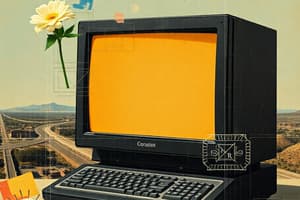Podcast
Questions and Answers
How is the speed of a processor measured?
How is the speed of a processor measured?
- In gigahertz (GHz) (correct)
- In terahertz (THz)
- In megahertz (MHz)
- In kilohertz (kHz)
What was one disadvantage of the first generation of computers?
What was one disadvantage of the first generation of computers?
- Compact size
- Manual programming in machine language (correct)
- High durability due to solid-state components
- High processing speed
What is the relationship between hertz and processing speed?
What is the relationship between hertz and processing speed?
- Higher hertz indicates slower processing
- Higher hertz means faster instruction processing (correct)
- Lower hertz results in more instructions processed
- Hertz has no impact on processing speed
Which characteristic is associated with first generation computers?
Which characteristic is associated with first generation computers?
What one of the following issues made first generation computers fragile?
What one of the following issues made first generation computers fragile?
What happens as the number of hertz increases?
What happens as the number of hertz increases?
Which option describes the impact of higher hertz on instruction processing?
Which option describes the impact of higher hertz on instruction processing?
How did the performance of first generation computers compare to later generations?
How did the performance of first generation computers compare to later generations?
What is the primary role of the Control Unit in a computer system?
What is the primary role of the Control Unit in a computer system?
What unit of measurement is not used for processor speed?
What unit of measurement is not used for processor speed?
Which of these was NOT a disadvantage of first generation computers?
Which of these was NOT a disadvantage of first generation computers?
Which unit is responsible for performing arithmetic, comparison, and logical operations?
Which unit is responsible for performing arithmetic, comparison, and logical operations?
What is the primary function of I/O modules in a computer system?
What is the primary function of I/O modules in a computer system?
What would happen if a computer system lacked a Control Unit?
What would happen if a computer system lacked a Control Unit?
Which of the following is NOT a function of the Arithmetic Logic Unit (ALU)?
Which of the following is NOT a function of the Arithmetic Logic Unit (ALU)?
Which of the following is NOT considered part of the external environment for a computer system?
Which of the following is NOT considered part of the external environment for a computer system?
Which component ensures that the different parts of a computer system work together effectively?
Which component ensures that the different parts of a computer system work together effectively?
Which of the following examples falls under secondary memory devices?
Which of the following examples falls under secondary memory devices?
I/O modules mainly interact with which of the following?
I/O modules mainly interact with which of the following?
What role does communications equipment play in relation to I/O modules?
What role does communications equipment play in relation to I/O modules?
What is the primary function of the operating system architecture?
What is the primary function of the operating system architecture?
Which of the following is a key component of interrupt handling in operating systems?
Which of the following is a key component of interrupt handling in operating systems?
Which statement accurately describes system calls in an operating system?
Which statement accurately describes system calls in an operating system?
What is one of the main purposes of the operating system structure?
What is one of the main purposes of the operating system structure?
How does an operating system handle multiple interrupt requests?
How does an operating system handle multiple interrupt requests?
What is the primary characteristic of a microkernel architecture?
What is the primary characteristic of a microkernel architecture?
In microkernel architecture, where are the rest of the OS services found?
In microkernel architecture, where are the rest of the OS services found?
What role does the kernel play in a microkernel operating system?
What role does the kernel play in a microkernel operating system?
Which statement about microkernel architecture is accurate?
Which statement about microkernel architecture is accurate?
How does placing services outside the kernel benefit a microkernel system?
How does placing services outside the kernel benefit a microkernel system?
Flashcards
Processor Speed Measurement
Processor Speed Measurement
The speed of a processor is measured in Gigahertz (GHz).
Higher Hertz = Faster Processing
Higher Hertz = Faster Processing
The higher the GHz, the faster the processor can execute instructions.
What is Gigahertz?
What is Gigahertz?
Gigahertz (GHz) is a unit of measurement for frequency, specifically the number of cycles per second.
Processor Instructions
Processor Instructions
Signup and view all the flashcards
Processor's Role
Processor's Role
Signup and view all the flashcards
I/O Modules
I/O Modules
Signup and view all the flashcards
External Environment
External Environment
Signup and view all the flashcards
Secondary Memory Devices
Secondary Memory Devices
Signup and view all the flashcards
Communication Equipment
Communication Equipment
Signup and view all the flashcards
Terminals
Terminals
Signup and view all the flashcards
Control Unit
Control Unit
Signup and view all the flashcards
Arithmetic Logic Unit (ALU)
Arithmetic Logic Unit (ALU)
Signup and view all the flashcards
What does the Control Unit do?
What does the Control Unit do?
Signup and view all the flashcards
What are some operations the ALU performs?
What are some operations the ALU performs?
Signup and view all the flashcards
Processor
Processor
Signup and view all the flashcards
Operating System Architecture
Operating System Architecture
Signup and view all the flashcards
Kernel
Kernel
Signup and view all the flashcards
System Calls
System Calls
Signup and view all the flashcards
Interrupt
Interrupt
Signup and view all the flashcards
Interrupt Handler
Interrupt Handler
Signup and view all the flashcards
Machine Language
Machine Language
Signup and view all the flashcards
Disadvantages of Early Computers
Disadvantages of Early Computers
Signup and view all the flashcards
Second Generation Computers
Second Generation Computers
Signup and view all the flashcards
Vacuum Tubes
Vacuum Tubes
Signup and view all the flashcards
Why were early computers slow?
Why were early computers slow?
Signup and view all the flashcards
Microkernel Architecture
Microkernel Architecture
Signup and view all the flashcards
What's in the Microkernel?
What's in the Microkernel?
Signup and view all the flashcards
Where are OS Services?
Where are OS Services?
Signup and view all the flashcards
System Application Program
System Application Program
Signup and view all the flashcards
Benefits of Microkernel?
Benefits of Microkernel?
Signup and view all the flashcards
Study Notes
Operating Systems 1 - TECM 111
- Course title: Operating Systems 1
- Course code: TECM 111
- This course is part of Cloud Academy
Chapter 1: Introduction to Operating System
- Chapter outline:
- Introduction
- Computer system: overview and organization
- OS History, objectives, services and interfaces
- Operating System Structure: Architecture, Interrupt handling, System Call
- Conclusion
II. Computer System: Overview
- Computer: electronic device for storing, retrieving, and processing data
- Composed of two main parts: hardware and software
- Hardware: Physical components
- Software: Set of programs to perform functions
II. Computer System: Organization
- Motherboard: Main circuit board, holds components (CPU, RAM) and connectors for other components
- Processor (CPU): Controls computer operations and processes data
- Speed measured in Gigahertz (GHz)
- Higher hertz = faster processing
- Control Unit: Directs and coordinates computer operations
- Arithmetic Logic Unit (ALU): Performs arithmetic, comparison, and logical operations
- Memories: Stores data and programs
- RAM (Random Access Memory): Volatile memory, data lost when computer is shut down
- ROM (Read-Only Memory): Non-volatile memory, stores startup instructions
- Cache Memory: High-speed memory, acts as a buffer between RAM and CPU
- I/O Modules: Moves data between computer and external environment
- Includes various devices like disks, communications equipment, and terminals
- System Bus: Circuit paths for transmitting data and signals among computer components
- Three main types: Data Bus, Address Bus, and Control Bus
- Adapter Cards: Circuits allowing communication with peripherals (e.g., network card, video card)
III. OS History, objectives, services and interfaces
- 3.1 OS History: Computers and operation system evolution
- First generation (1945-1955):
- Computers were manual and relied heavily on physical components
- No operating systems; programmers interacted directly with hardware
- Second generation (1955-1965):
- Improvements like Transistors
- Less fragile and more efficient; batch operating systems, mainframes
- Third generation (1965-1980):
- Integrated circuits (ICs)
- Introduction of Multiprogramming, leading to better resource utilization
- Increased speed and efficiency
- Fourth generation (1980-present):
- Microprocessors: Faster processing, more reliable, and miniaturization
- Sophisticated operating systems (MS-DOS, Macintosh, Windows, Linux)
- First generation (1945-1955):
III. OS History, objectives, services and interfaces Continued
- 3.2 Operating System: Objectives
- The primary objective of an OS is to allow easy and efficient use of computer software and hardware
- Achieve this by offering different services and a user interface
III. OS History, objectives, services and interfaces Continued
- 3.3 Operating System: Services
- User/computer interface
- Resource manager: Manages computer resources,
- Program development: Facilitates the creation of programs (editors and debuggers)
- Program execution: Manages execution of programs
- Memory management: Manages memory allocation and utilization for programs
- Access to I/O (Input/Output) devices: Enables programs to interact with various devices
- Controlled access to files (File management): Manages files and directories
- System access: Provides control and security to the system
- Error detection and response
- Accounting: Collecting usage statistics
- Security: Protecting resources from unauthorized access via authentication
III. OS History, objectives, services and interfaces Continued
- 3.4 Operating System: Interfaces
- User interface: Software layer enabling user interaction, includes command processor and visual components
- Types of user interfaces:
- Command-line interface
- Graphical user interface (GUI)
IV. Operating System Structure: Architecture, Interrupt handling, System Call
- 4.1 Operating System Structure: Architecture
- Monolithic operating system:
- Simple structure, places all components (file management, memory management, etc.) directly within the kernel
- Layered operating system:
- Organizes components into layers, each layer communicating with layers above and below
- Microkernel operating system:
- Design where most components operate outside the kernel, with lower privilege level.
- Monolithic operating system:
- 4.2 Interrupt handling:
- External signals notifying the CPU about events, e.g., I/O device needs attention
- Used to stop current tasks and execute a relevant procedure in the OS
- 4.3 System calls:
- Programs instruct the operating system to perform operations on their behalf
- Methods for requesting services from the operating system kernel.
V. Conclusion
- Overview of computer architecture and operating system importance
- History of operating systems
- Focus on hardware management in the next chapter
Studying That Suits You
Use AI to generate personalized quizzes and flashcards to suit your learning preferences.




